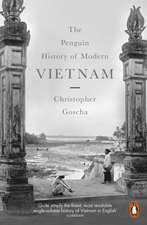Hiroshima: The Origins of Global Memory Culture
Autor Ran Zwigenbergen Limba Engleză Paperback – 24 feb 2016
| Toate formatele și edițiile | Preț | Express |
|---|---|---|
| Paperback (1) | 313.51 lei 6-8 săpt. | |
| Cambridge University Press – 24 feb 2016 | 313.51 lei 6-8 săpt. | |
| Hardback (1) | 645.26 lei 6-8 săpt. | |
| Cambridge University Press – 14 sep 2014 | 645.26 lei 6-8 săpt. |
Preț: 313.51 lei
Nou
Puncte Express: 470
Preț estimativ în valută:
59.99€ • 62.63$ • 49.65£
59.99€ • 62.63$ • 49.65£
Carte tipărită la comandă
Livrare economică 04-18 aprilie
Preluare comenzi: 021 569.72.76
Specificații
ISBN-13: 9781107416598
ISBN-10: 1107416590
Pagini: 348
Ilustrații: 18 b/w illus.
Dimensiuni: 154 x 230 x 18 mm
Greutate: 0.47 kg
Editura: Cambridge University Press
Colecția Cambridge University Press
Locul publicării:New York, United States
ISBN-10: 1107416590
Pagini: 348
Ilustrații: 18 b/w illus.
Dimensiuni: 154 x 230 x 18 mm
Greutate: 0.47 kg
Editura: Cambridge University Press
Colecția Cambridge University Press
Locul publicării:New York, United States
Cuprins
Acknowledgements; Introduction; 1. 'The most modern city in the world': city planning, commemoration and atomic power in Hiroshima, 1945–55; 2. Modernity's angst: survivors between shame and pride: 1945–60; 3. Socialist bombs and peaceful atoms: exhibiting modernity and fighting for peace in Hiroshima, 1955–62; 4. Healing a sick world: Robert Lifton, PTSD, and the psychiatric reassessment of survivors and trauma; 5. The Hiroshima Auschwitz Peace March and the globalization of victimhood; 6. A sacred ground for peace: violence, tourism and the sanctification of the Peace Park, 1963–75; 7. Peeling the red apple: the Hiroshima Auschwitz Committee and the Hiroshima-Auschwitz museum, 1973–95; Conclusion: the other ground zero? Hiroshima, Auschwitz, 9.11 and the world between them; Index.
Recenzii
'This brilliant book reminds us of how Hiroshima and Auschwitz were first paired in the Cold War emotional imaginary and explicates beautifully the tensions between messages of peace and commodification of atrocity, and between instrumentalization and sanctification of survivors.' Dagmar Herzog, City University of New York
'Through his rich and thought-provoking study of commemoration at Hiroshima, Ran Zwigenberg opens up the novel topic of how World War II was remembered in different ways the world over. Full of both comparative and transnational insights, this book is not only insightful about Japanese history but also intimates a promising set of inquiries into global memory culture.' Samuel Moyn, Harvard University, Massachusetts
'In a major contribution to memory studies, Zwigenberg controversially links Hiroshima and the Holocaust through the figure of the 'victim-hero' in the stories we tell of both of them. His conclusions are unsettling but necessary.' John Whittier Treat, Yale University, Connecticut
'Zwigenberg charts the course of how the citizens of Hiroshima, and the Japanese in general, transformed the city from a site that longed for peace in the postwar period to a place of remembrance of war horrors in more recent decades … recommended.' Choice
'An exceptional combination of meticulous and multi-level archival research with a strong critical voice.' Reviews in History
'This is an exciting topic, treated here with an impressive, unprecedented range and depth of research, as its purview extends from Hiroshima to Israel. The author's archival excavations include local newspapers carrying articles on the atomic bombing and personal interviews. He takes up topics from architecture to psychiatry in examining the sociocultural transformation in the construction of memory from 1945 to 1995. As all this should suggest, the book's main value is in its descriptive richness, the abundance and diversity of the information it presents.' Yuki Miyamoto, The Journal of Japanese Studies
'Through his rich and thought-provoking study of commemoration at Hiroshima, Ran Zwigenberg opens up the novel topic of how World War II was remembered in different ways the world over. Full of both comparative and transnational insights, this book is not only insightful about Japanese history but also intimates a promising set of inquiries into global memory culture.' Samuel Moyn, Harvard University, Massachusetts
'In a major contribution to memory studies, Zwigenberg controversially links Hiroshima and the Holocaust through the figure of the 'victim-hero' in the stories we tell of both of them. His conclusions are unsettling but necessary.' John Whittier Treat, Yale University, Connecticut
'Zwigenberg charts the course of how the citizens of Hiroshima, and the Japanese in general, transformed the city from a site that longed for peace in the postwar period to a place of remembrance of war horrors in more recent decades … recommended.' Choice
'An exceptional combination of meticulous and multi-level archival research with a strong critical voice.' Reviews in History
'This is an exciting topic, treated here with an impressive, unprecedented range and depth of research, as its purview extends from Hiroshima to Israel. The author's archival excavations include local newspapers carrying articles on the atomic bombing and personal interviews. He takes up topics from architecture to psychiatry in examining the sociocultural transformation in the construction of memory from 1945 to 1995. As all this should suggest, the book's main value is in its descriptive richness, the abundance and diversity of the information it presents.' Yuki Miyamoto, The Journal of Japanese Studies
Notă biografică
Descriere
An original and compelling new analysis of Hiroshima's place within the global development of Holocaust and World War II memory.











